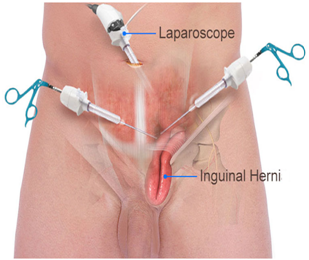Hernia
A hernia is protrusion of a part of intra-abdominal organ such as intestine or omentum (fat of abdomen) through a musculo-fascial weakness in the wall of the abdomen. This weakness can be congenital or acquired (after surgery/pregnancy/trauma). This results in buldge at various parts of the abdomen which are initially reducible i.e. can go within the abdomen when the muscles are relax and abdominal pressure decreases and increase in size of the buldge is noticed while coughing and straining.
abdomen) through a musculo-fascial weakness in the wall of the abdomen. This weakness can be congenital or acquired (after surgery/pregnancy/trauma). This results in buldge at various parts of the abdomen which are initially reducible i.e. can go within the abdomen when the muscles are relax and abdominal pressure decreases and increase in size of the buldge is noticed while coughing and straining.
To start with hernia are painless but pain at the site of the hernia suggest developing complications as the neck of the hernia (the part of the musculo-fascial defect) can constrict and strangulate the contents of the hernia which results in cut-off of the blood supply of the contents resulting into serious complications.
In the natural course of the hernia, it never disappears or get treated by itself and with time increases in size with increase risk of complications.
Types of Hernia:
- Inguinal
- Umbilical
- Femoral
- Incisional (Post-operative)
- Ventral
- Lumbar
Irrespective of the type of the hernia timely Surgery is the only definitive treatment.
Common clinical features of hernia:
- A buldge/swelling in the region of hernia which typically reduces in size on relaxation or lying down and increases in size on coughing and straining.
- Dull or stretching type of pain over the region of swelling
- A dragging sensation
- Weakness/ burning or aching sensation around the buldge
Complications of the Hernia: .png)
- Irreducibility- when the hernia contents forms adhesions with the hernia sac which commonly happens in the long standing cases the Hernia which was once completely reducible may become partially reducible or irreducible.
- Strangulation- When the blood supply of the hernia contents is compromised which results in dying off of the contents of the hernia called as necrosis and gangrene of the contents. This is a serious life threatening complication of the hernia and requires life saving immediate surgical intervention.
- Gangrene- A life threatening condition requiring urgent surgical intervention. Its clinical features include intense pain over the region of hernia along with nausea and vomiting and generalized features of sepsis.
Causes of Hernia:
- Increased pressure within the abdomen such as in pregnancy, heavy weight exercise etc.
- A congenital weak spot in the abdomen
- Prolonged constipation or straining during bowel movements
- Chronic coughing
Diagnosis-
- Hernia is usually a clinical diagnosis and do not require any special tests to be done.
- Confirmation of the hernia defect and its contents when desired can be done by Ultrasonography or Computed Tomography (CT) Imaging.
- Routine Blood tests and tests for anaesthesia fitness are required to be done.
Treatment:
- Surgery is the only definitive treatment of Hernia.

- After reduction of the contents of the Hernia within the abdomen where they belong, the gap/defect in the musculo-fascial layer of the abdomen is covered with a mesh so that the defect can be patched and hernia is cured.
- There are a variety of meshes available for the repair of the hernia called meshplasty. Preference of mesh to be used depends upon the type of hernia.
- Usually the hernia is repaired with Minimally invasive surgery by making 3-4 key holes in the abdomen which do not require any sutures or dressings.
- There are no dietary restrictions in an elective hernia repair and patient can resume their daily routine within 24 hours after the surgery.
- The usual stay in hospital is for a day and patient can be discharged within 24 hours after the surgery.


 abdomen) through a musculo-fascial weakness in the wall of the abdomen. This weakness can be congenital or acquired (after surgery/pregnancy/trauma). This results in buldge at various parts of the abdomen which are initially reducible i.e. can go within the abdomen when the muscles are relax and abdominal pressure decreases and increase in size of the buldge is noticed while coughing and straining.
abdomen) through a musculo-fascial weakness in the wall of the abdomen. This weakness can be congenital or acquired (after surgery/pregnancy/trauma). This results in buldge at various parts of the abdomen which are initially reducible i.e. can go within the abdomen when the muscles are relax and abdominal pressure decreases and increase in size of the buldge is noticed while coughing and straining..png)

